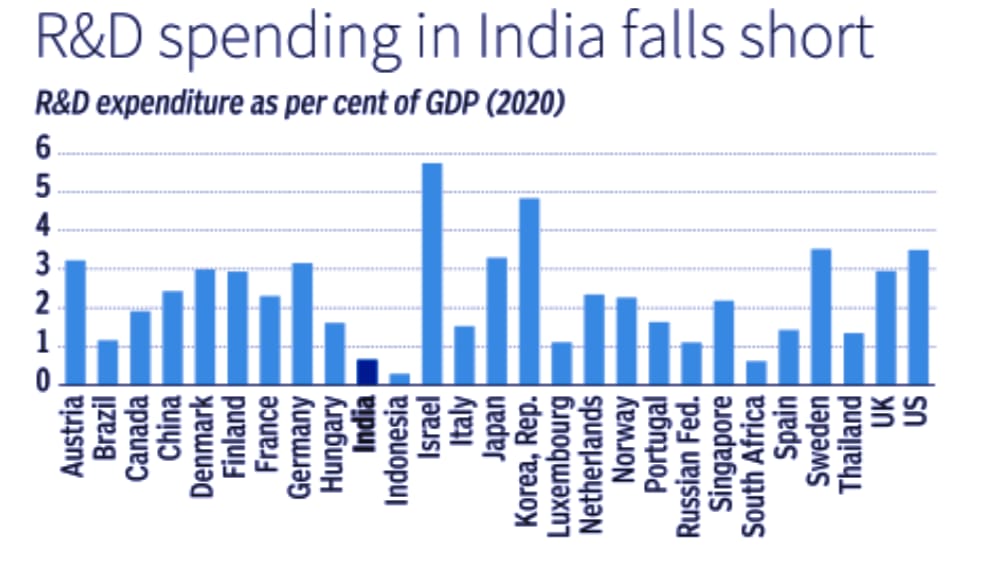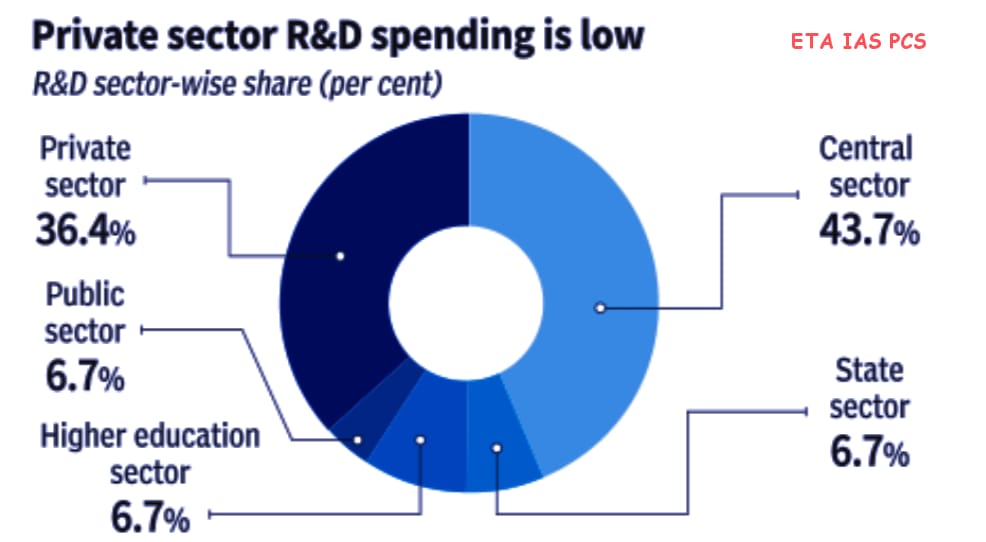CONTEXT: India possesses a substantial scientific workforce, a well-established information technology and pharmaceutical industry, as well as a vibrant start-up ecosystem; however, it still falls short in terms of investment in research and development (R&D).
Subpoints:
Low R&D Investment Relative to Global Standards:
India’s Gross Expenditure on R&D (GERD) stands at only 0.64% of its GDP in FY21, which is significantly lower than that of global leaders such as the US, China, Japan, and South Korea.Limited Private Sector Contribution:
The private sector’s involvement in R&D remains limited, with the majority of funding coming from the government.
Challenges in R&D Growth:
India’s Low R&D Spending:
India’s Gross Expenditure on R&D (GERD) increased from ₹60,196 crore in FY2011 to ₹1,27,381 crore in FY2021. However, this growth is still limited in comparison to global standards.R&D as a Percentage of GDP:
India spends only 0.64% of its GDP on R&D, while China invests 2.1%, and countries like the US, Japan, and South Korea allocate over 3%.Limited Private-Sector Involvement:
In developed nations, the private sector contributes around 70% of R&D funding. In contrast, India’s R&D is primarily funded by the government, which limits innovation and growth in the sector.

Sector-wise R&D Expenditure:
- Pharmaceuticals (50%): Driven by drug innovation and vaccine research, this sector leads India’s R&D spending.
- IT (15%): Investments focus on advancements in AI, cybersecurity, and software development.
- Transportation (10%): Significant R&D is directed towards electric vehicles (EVs), autonomous vehicles, and infrastructure development.
- Defence & Chemicals (7-10%): Investments in military technology and chemical innovations are key drivers in this sector.
- Biotechnology: Growing focus on medical research and genetic engineering.
- Electronics, Fuels, Telecommunications, Metallurgy: These sectors show relatively lower R&D investment, possibly due to their maturity or slower adoption of new technologies.
Private Sector’s Limited Role:
- While globally private firms contribute 50-70% of R&D spending, in India, the government funds most of the R&D. Indian firms are often reluctant to invest in long-term R&D due to uncertain returns, and high costs deter startups and MSMEs from entering the R&D space.
Top R&D Spenders Globally:
- US: Companies like Google and Amazon dominate private-sector R&D, contributing around 70% of the nation’s R&D expenditure.
- China: The country operates a hybrid model with both state and private sector contributions driving R&D growth.

Focus on Basic Research Over Applied Research:
Limited Industry Linkages:
While applied research drives commercial innovation and attracts investment, India’s academic institutions predominantly focus on theoretical or basic research. This emphasis on fundamental science often results in fewer connections between research institutions and industries, hindering technology transfer from labs to businesses.Need for Investment in Disruptive Technologies:
Current R&D investments are mainly concentrated in sectors like pharmaceuticals and IT. However, emerging technologies such as quantum computing, semiconductors, and AI require more focused funding and research efforts to drive innovation and economic growth.
Government Initiatives to Foster R&D Development
Significant Increase in GERD (2013-14 to 2021-22):
The government has substantially increased its R&D expenditure from ₹60,196 crore in FY2013-14 to ₹1,27,381 crore in FY2021-22, demonstrating a strong commitment to advancing key sectors such as artificial intelligence, biotechnology, semiconductors, and quantum technology.Establishment of the National Research Foundation (NRF):
The NRF aims to bridge the gap between academic institutions and industry, fostering multidisciplinary research collaborations that can drive innovation and practical applications.Production-Linked Incentive (PLI) Scheme for Technological Sectors:
The PLI scheme encourages R&D in critical areas like electronics, semiconductors, and renewable energy, offering incentives to domestic manufacturers and researchers.Tax Benefits for R&D Investments:
The government offers weighted tax deductions for companies that invest in research and development activities, incentivizing private sector involvement in innovation.Atal Innovation Mission (AIM):
AIM supports the growth of startups, incubators, and innovation centers within educational institutions, fostering an ecosystem that nurtures new ideas and entrepreneurial ventures.
Despite a strong presence in the IT, pharmaceutical, and startup sectors, India’s overall R&D investment remains relatively low. To enhance global competitiveness and achieve technological self-sufficiency, it is essential to boost collaboration between industry and academia, increase private sector investment, and place greater emphasis on applied research.
